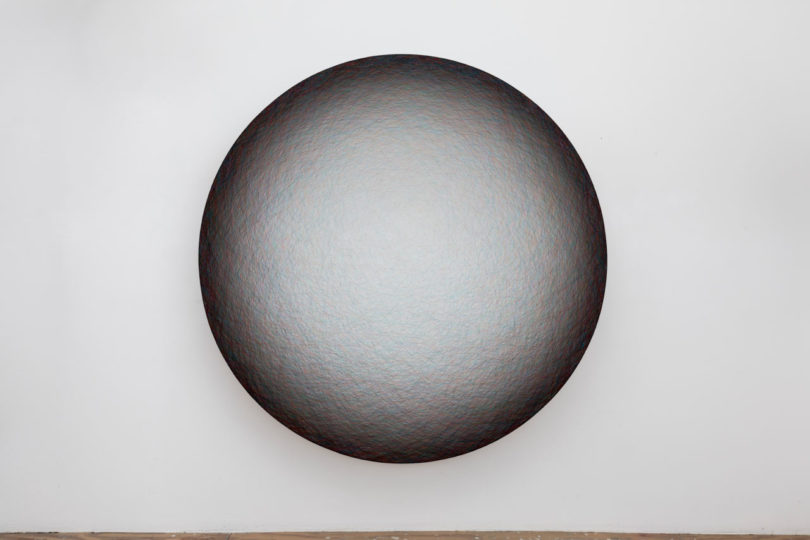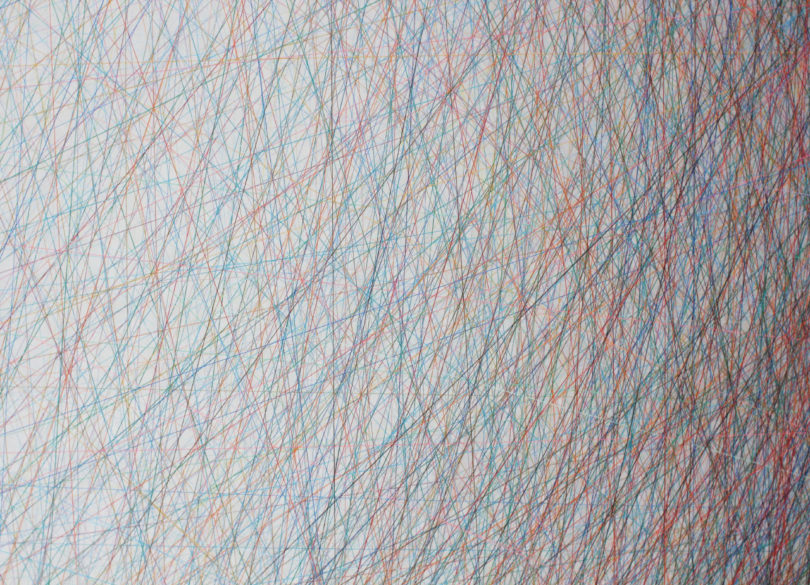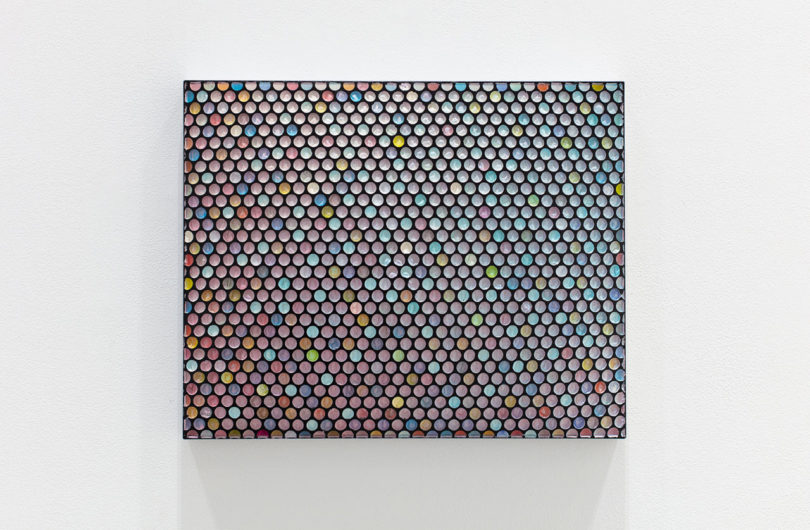Artist Emil Lukas works in a range of “common” materials to produce unique series of works that all share a superhuman (and sometimes “non human”) commitment to process. His current exhibition at Sperone Westwater in New York mixes new work from four different series across three floors of the gallery. Here’s each series broken down and why this isn’t one to miss.
THREAD
Lukas’ thread “paintings” (he calls nearly everything he does “painting” regardless of the material) have always been my personal favorite. In each, THOUSANDS of thin threads stretch across an empty frame, create a smooth ombré into literal thin air. The many colors of threads are all placed “with intention”- which means that rather than relying on a machine or mathematical system, Emil is THINKING and deciding about the placement at every tiny step of the way.
The show features 2 circular thread works for the very first time, both nearly 80-inches in diameter with bowl-like concave back that results in a the illusion of infinite space behind the matrix of thread. And in a possible wink to the navigational directions in their titles, “twin orbit south” is displayed on the lowest (ground) floor, and “twin orbit north” is featured on the highest (3rd) floor.
BUBBLE WRAP
Multiple polka-dot paintings are created by casting bubble wrap in white plaster and painting the circles individually with acyclic paint.
The surface on each work bulges outwards at the center, as if the weight of the plaster pushed the thin plastic outward on the frame. The effect of concave “bubbles” bending across a convex whole is surprisingly mesmerizing in person.
In a few of the works, like “for more” (below), popped bubbles result in attention-pulling blanks in the pattern.
LARVAE
Emil Lukas is most notorious for his larvae paintings – a process which involves personally raising fly larvae at specific times of the year under necessary weather conditions, then allowing them to drag wet ink across a surface, often directed by light and shadow.
And if you’re curious or concerned, ArtNet did an in-depth interview a few years ago about the whole process, where Lukas does mention the eventual fate of the larvae (they’re unharmed):
“From the time they are larvae until the time they pupate, I intervene at this little interval,” he says. “We make these paintings, and then the larvae are outside again; they hatch, they fly away—they fly all over the community.” (via ArtNet)
His newest work in the larvae series is titled “the location of possible and impossible moves” comprises 40 individual panels.
Though his other series don’t include living crawly things, it’s difficult not to think about various insects and arachnids when seeing them all together. For me, the threads suddenly resemble insanely-complex spiderwebs and the bubble wrap can feel like technicolor honeycombs. I think it’s less a direct “insect inspiration” (I don’t think he’s ever mentioned it) than a shared process of accomplishing something magical: Thousands of tiny “moves” that add up to an unbelievable and complex whole.
STACKS
Emil’s “stacks” are square columns measuring 6-7 feet tall that are composed of multiple individual works stacked on top of each other.
They function both as sculpture when displayed in the gallery AND a massive unbound book (for the owner only). The future owner can lift off the top frame and place it upside-down on the floor, as if turning a page. The process is repeated with every layer until the sculpture is re-stacked and fully reversed. Each stack can include smaller versions of the bubble wrap, thread, and larvae paintings, along with new experiments in an even wider range of materials. Even without seeing each individual works (don’t touch the sculptures), peaking between the cracks and recognizing larvae trails and other favorites is plenty entertaining.
The joy of viewing the art of Emil Lukas is not just the electric visual buzz of color and pattern, it’s also imagining the unseen process and performance of the thousands of decisions that are held in each work. If you’re in New York, it’s well worth a visit to all 3 floors before the show closes this week.
What: Emil Lukas: New Work
Where: Sperone Westwater Gallery, 256 Bowery, New York
When: January 9 – February 23, 2019
Images: © Emil Lukas, Courtesy Sperone Westwater, New York. All installation & artwork images provided by gallery. All “detail” images photographed by the author David Behringer.
from Design MilkDesign Milk https://design-milk.com/emil-lukas-the-art-of-bubble-wrap-thread-and-larvae/

















No comments:
Post a Comment